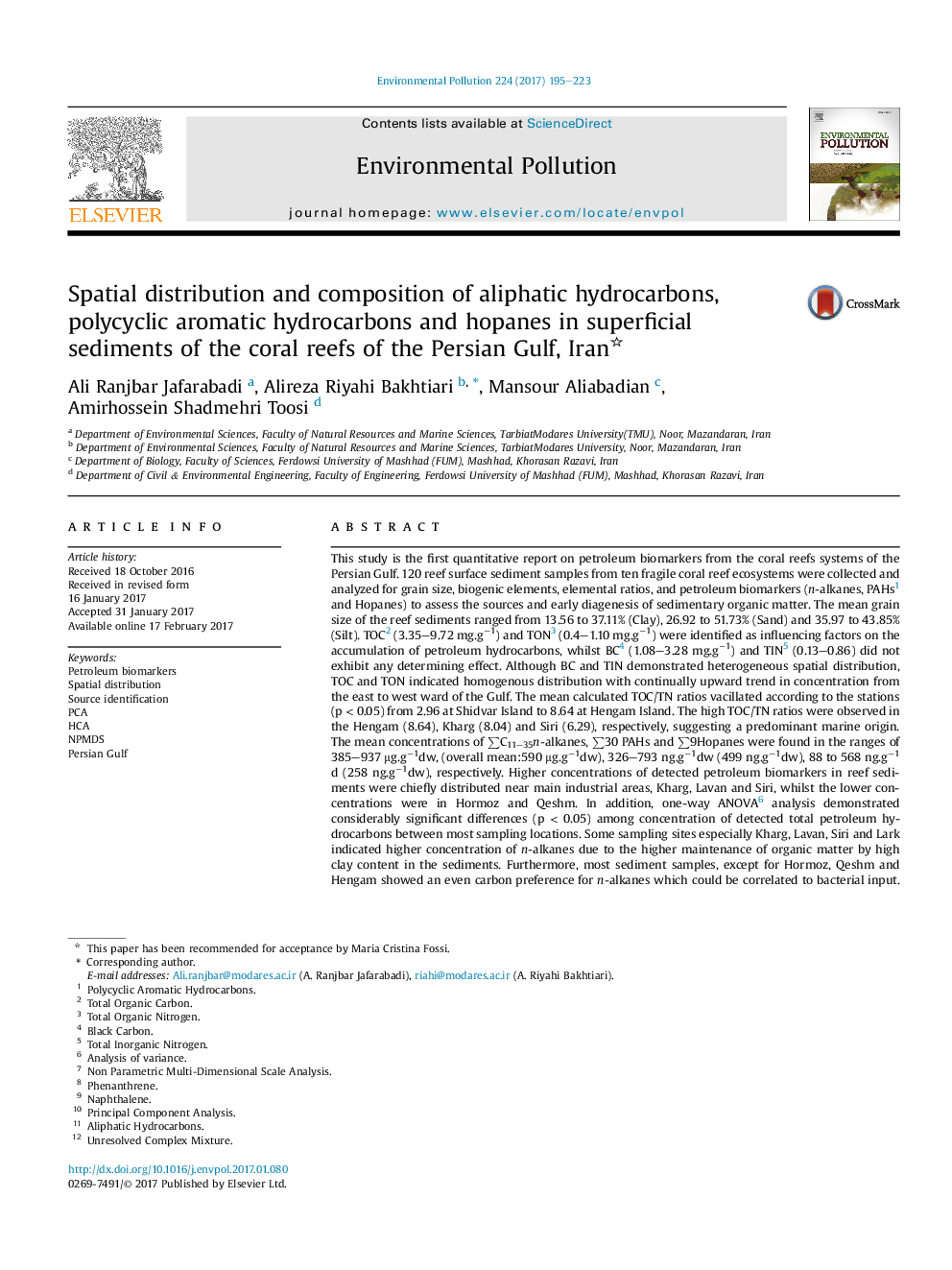| Article ID | Journal | Published Year | Pages | File Type |
|---|---|---|---|---|
| 5749376 | Environmental Pollution | 2017 | 29 Pages |
â¢A continuously escalating trend is observable in accumulation of petroleum biomarkers from east to west part of the Persian Gulf.â¢BC and TIN indicated heterogeneous spatial distribution, while TOC and TON exhibited homogenous distribution.â¢Reef sediments of Kharg, Lavan and Siri Islands exhibited high values of petroleum biomarkers.â¢Reef sediment texture, biogenic elements and distance from the Island influences the spatial distribution of petroleum biomarkers.â¢PCA and NPMDS analysis showed significant abundance of LMWPAHs, even-numbered carbons plus C30αβ and C29αβ in the study area.
This study is the first quantitative report on petroleum biomarkers from the coral reefs systems of the Persian Gulf. 120 reef surface sediment samples from ten fragile coral reef ecosystems were collected and analyzed for grain size, biogenic elements, elemental ratios, and petroleum biomarkers (n-alkanes, PAHs1 and Hopanes) to assess the sources and early diagenesis of sedimentary organic matter. The mean grain size of the reef sediments ranged from 13.56 to 37.11% (Clay), 26.92 to 51.73% (Sand) and 35.97 to 43.85% (Silt). TOC2 (3.35-9.72 mg.gâ1) and TON3 (0.4-1.10 mg.gâ1) were identified as influencing factors on the accumulation of petroleum hydrocarbons, whilst BC4 (1.08-3.28 mg.gâ1) and TIN5 (0.13-0.86) did not exhibit any determining effect. Although BC and TIN demonstrated heterogeneous spatial distribution, TOC and TON indicated homogenous distribution with continually upward trend in concentration from the east to west ward of the Gulf. The mean calculated TOC/TN ratios vacillated according to the stations (p < 0.05) from 2.96 at Shidvar Island to 8.64 at Hengam Island. The high TOC/TN ratios were observed in the Hengam (8.64), Kharg (8.04) and Siri (6.29), respectively, suggesting a predominant marine origin. The mean concentrations of âC11-35n-alkanes, â30 PAHs and â9Hopanes were found in the ranges of 385-937 μg.gâ1dw, (overall mean:590 μg.gâ1dw), 326-793 ng.gâ1dw (499 ng.gâ1dw), 88 to 568 ng.gâ1 d (258 ng.gâ1dw), respectively. Higher concentrations of detected petroleum biomarkers in reef sediments were chiefly distributed near main industrial areas, Kharg, Lavan and Siri, whilst the lower concentrations were in Hormoz and Qeshm. In addition, one-way ANOVA6 analysis demonstrated considerably significant differences (p < 0.05) among concentration of detected total petroleum hydrocarbons between most sampling locations. Some sampling sites especially Kharg, Lavan, Siri and Lark indicated higher concentration of n-alkanes due to the higher maintenance of organic matter by high clay content in the sediments. Furthermore, most sediment samples, except for Hormoz, Qeshm and Hengam showed an even carbon preference for n-alkanes which could be correlated to bacterial input. NPMDS7 analysis also demonstrated that among the congeners of petroleum biomarkers, n-C12,n-C14, n-C16,n-C18 and n-C20 for n-alkanes, Phe8 and Naph9 along with their Alkyl homologues for PAHs (2-3 rings accounted for 60%) and C30αβ and C29αβ for Hopanes were discriminated from their other congeners in the whole study area. Our results based on the PCA10 analysis and diagnostic indices of AHs11 and PAHs along with ring classification of PAHs, in addition, the ubiquitous presence of UCM,12 and Hopanes revealed that the main sources of the pollution were petroleum and petroleum combustion mainly from offshore oil exploration and extraction, discharge of pollutants from shipping activities.
Graphical abstractDownload high-res image (596KB)Download full-size image
